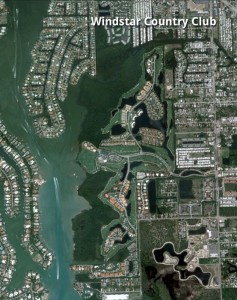Before restoration the elevated mounds of dredge spoil from navigation channel maintenance within Naples Bay were infested with large Australian pine (Casurina litoria) and Brazilian pepper (Schinus terebinthifolius). Mature, undisturbed basin mangrove forests adjoining this area were surveyed and used as reference sites. White mangroves (Laguncularia racemosa) and black mangroves (Avicennia germinans) were the predominant species in the reference area with lesser numbers of red mangrove (Rhizophora mangle) which were more common along the Naples Bay shoreline.
In fall of 1982 vegetation on the dredge spoil mounds was logged and chipped with all biomass removed utilizing temporary haul roads constructed through the adjacent mangrove forest. Kevin Erwin pioneered this technique in the late 1970’s with the successful restoration of four to five thousand of acres of mangrove/saltmarsh habitat in western Cape Coral, Florida on Matlacha Pass. Heavy equipment was used to remove more than 70,000 cubic yards of dredge spoil to the designed elevation to support the restored mangrove community. Narrow channels were dug to provide a means of tidal flushing and drainage critical to maintaining the soil chemistry and providing nutrients to the mangrove ecosystem. Lastly, the temporary haul roads were removed.
Although approximately 70,000 red mangrove propagules were hand planted in pairs on one-meter centers (according to a requirement by the Florida Department of Environmental Regulation) this planting as in most cases of mangrove restoration was not a necessary component required for successful restoration. Propagules from all mangrove species colonized the site in a few years along with oysters, crabs and seagrasses. Today, the restored mangroves are an integral part of the Naples Bay ecosystem.
